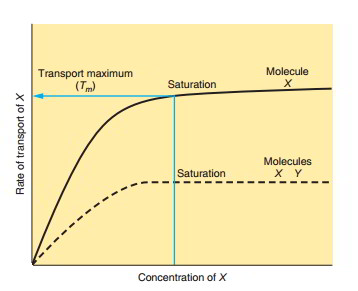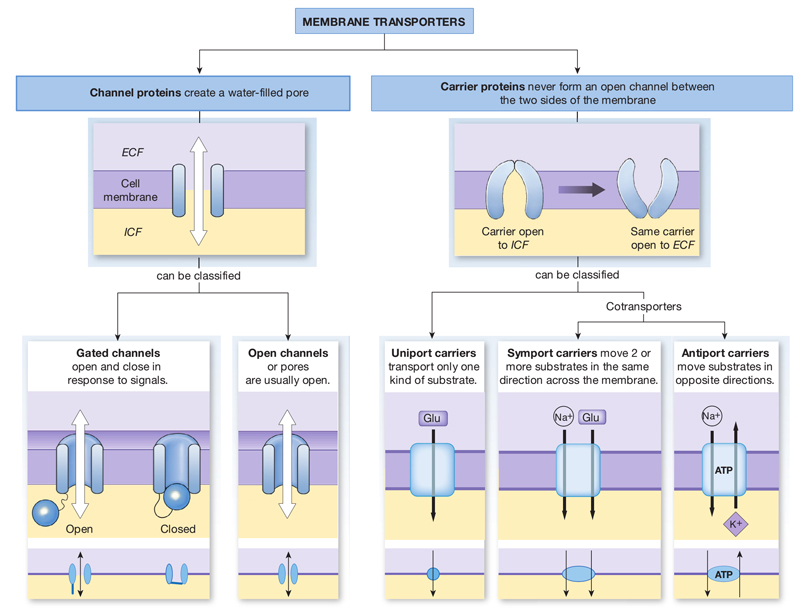The processes of membrane transport explained approximately this point do not always need a cell membrane; they can take place simply as well through artificial membranes Now. nevertheless, we concern processes for which a cell membrane is vital, since they use transport proteins to obtain through. Therefore, the next 2 processes are cases of carrier- moderated transport.
The carriers imitate enzymes in some methods: the solute is a ligand that binds to a particular receptor site on the carrier, like a substrate binding to the active site of an enzyme. The carrier shows uniqueness for a particular ligand, simply as an enzyme provides for its substrate. A glucose carrier, for instance, can not transport fructose. Carriers likewise display saturation; as the solute concentration increases, its rate of transport through a membrane boosts however just approximately a point. When every carrier is inhabited, including more solute can not make the process go any faster. The carriers are filled– say goodbye to are offered to manage the increased need, and transport levels off at a rate called the transport optimum (Tm). The Tm describes why glucose appears in the urine of individuals with diabetes mellitus. A crucial distinction in between a membrane carrier and an enzyme is that carriers do not chemically alter their ligands; they merely choose them up on one side of the membrane and release them, the same, on the other.
Kind of Carriers
Uniport
A uniport brings one solute at a time. For instance, a lot of cells drain calcium by ways of a uniport, preserving a low intracellular calcium concentration so that calcium salts do not take shape in the cytoplasm.
Symport
A symport brings 2 or more solutes through a membrane all at once in the very same direction; this process is called cotransport. As an example, absorptive cells of the little intestine and kidneys use up sodium and glucose all at once by ways of a symport.
Antiport
An antiport brings 2 or more solutes in opposite instructions; this process is called counter-transport. Almost all cells have an antiport called the sodium- potassium pump that constantly eliminates Na+from the cell and generates K+.
These carriers use 2 mechanisms of transport called facilitated diffusion and active transport.
Facilitated Diffusion
It is the carrier- moderated transport of a solute through a membrane down its concentration gradient. It is a passive transport process; that is, it does not take in ATP. It carries solutes, such as glucose, that can not travel through the membrane unaided. The solute connects to a binding site on the carrier, then the carrier modifications conformation and launches the solute on the other side of the membrane.
Active Transport
It is the carrier- moderated transport of a solute through a membrane up its concentration gradient, utilising energy offered by ATP. The calcium pumps discussed formerly utilise active transport Although Ca2+ is currently more focused in the ECF than within the cell, these carriers pump still more of it from the cell. Active transport likewise makes it possible for cells to soak up amino acids that are currently more focused in the cytoplasm than in the ECF.
A popular example of active transport is the sodium- potassium (Na+– K+) pump, likewise referred to as Na+– K+ ATPase since the carrier is an enzyme that hydrolyzes ATP. The Na+– K+pump binds 3 Na+all at once on the cytoplasmic side of the membrane, launches these to the ECF, binds 2 K+all at once from the ECF and launches these into the cell. Each cycle of the pump takes in one ATP and exchanges 3 Na+ for 2 K+ ,which keeps the K+concentration greater and the Na+concentration lower within the cell than they remain in the ECF. These ions constantly leak through the membrane and the Na+– K+pump compensates like bailing out a dripping boat.
Lets you question the significance of the Na+– K+pump, about half of the calories you will utilize every day to perform this function alone. Beyond making up for a dripping plasma membrane, the Na+– K+pump has at least 4 functions:
- Regulation of cell volume. Particular anions are restricted to the cell and can not permeate the plasma membrane. These “set anions.” such as proteins and phosphates, draw in and keep cations. If there eliminates one ion more than it generates, the pumps belong to a negative feedback loop that decreases ion concentration, osmolarity, and cellular swelling.
- Secondary active transport The Na+– K+pump preserves a high concentration gradient of Na+and K+ between one side of the membrane and the other. Like water behind a dam that can be tapped to produce electricity, this gradient has a high potential energy that can own other processes Considering that Na+has a high concentration outside the cell, it has the tendency to diffuse back in. Some cells exploit this to move other solutes into the cell. In kidney tubules, for instance, the cells have Na+– K+pumps in the basal membrane that eliminate Na+from the cytoplasm and preserve a low intracellular Na+concentration. In the apical membrane, the cells have a facilitated diffusion carrier, the sodium- glucose transport protein (SGLT), which all at once binds Na+and glucose and brings both into the cell simultaneously. By making use of the propensity of Na+to diffuse down its concentration gradient into these cells, the SGLT takes in glucose and avoids it from being squandered in the urine The SGLT in itself does not take in ATP. However, it does depend upon the ATP-consuming Na+– K+pumps at the base of the cell. We state that glucose is taken in by secondary active transport, rather than the main active transport performed by the Na+– K+pump.
- Heat production When the weather turns cold, we show up not just the heating system in our house however likewise the “heating system” in our body. Thyroid hormone promotes cells to produce more Na+– K+pumps. As these pumps take in ATP. they release heat, making up for the body heat we lose to the cold air around us.
- Maintenance of a membrane potential All living cells have an electrical charge distinction called the resting membrane potential across the plasma membrane. Like the 2 poles of a battery, the within the membrane is adversely charged and the exterior is favourably charged. This distinction comes from the unequal circulation of ions on the 2 sides of the membrane, maintained by the Na+– K+pump. The membrane potential is vital to the function of nerve and muscle cells.



 (59 votes, average: 4.86 out of 5)
(59 votes, average: 4.86 out of 5)